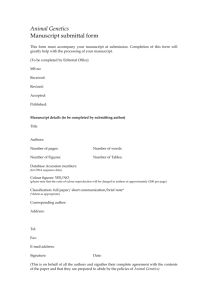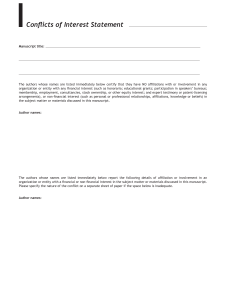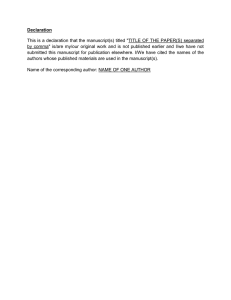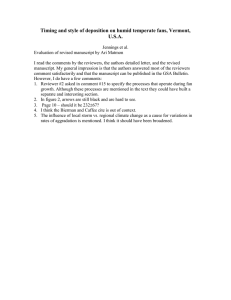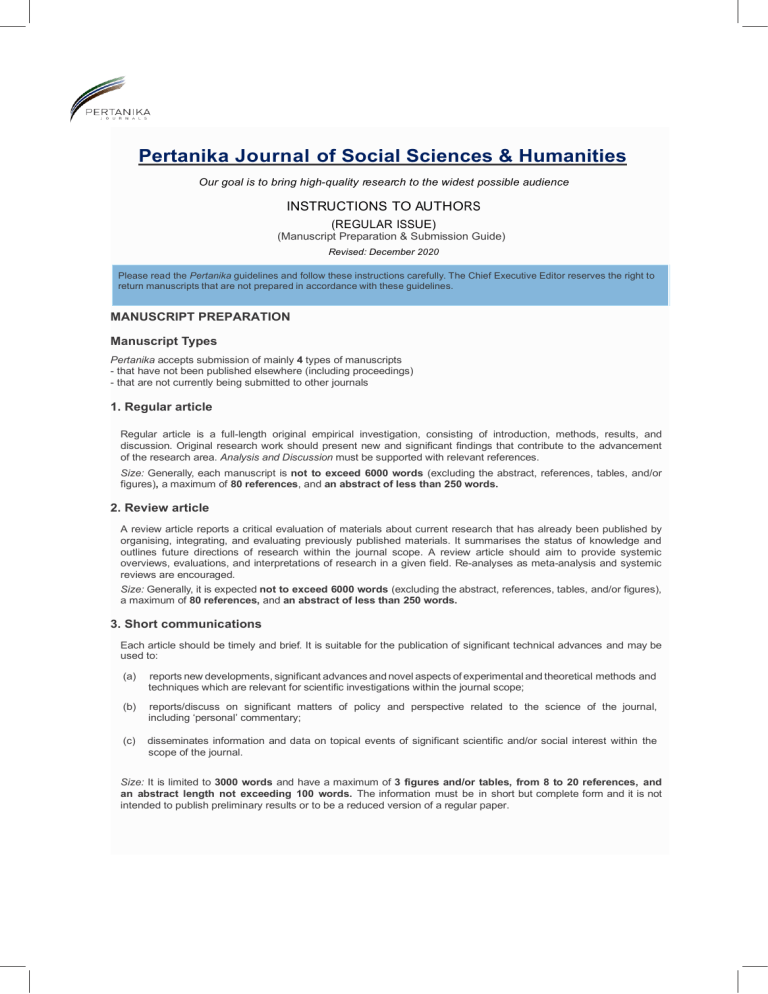
Pertanika Journal of Social Sciences & Humanities Our goal is to bring high-quality research to the widest possible audience INSTRUCTIONS TO AUTHORS (REGULAR ISSUE) (Manuscript Preparation & Submission Guide) Revised: December 2020 Please read the Pertanika guidelines and follow these instructions carefully. The Chief Executive Editor reserves the right to return manuscripts that are not prepared in accordance with these guidelines. MANUSCRIPT PREPARATION Manuscript Types Pertanika accepts submission of mainly 4 types of manuscripts - that have not been published elsewhere (including proceedings) - that are not currently being submitted to other journals 1. Regular article Regular article is a full-length original empirical investigation, consisting of introduction, methods, results, and discussion. Original research work should present new and significant findings that contribute to the advancement of the research area. Analysis and Discussion must be supported with relevant references. Size: Generally, each manuscript is not to exceed 6000 words (excluding the abstract, references, tables, and/or figures), a maximum of 80 references, and an abstract of less than 250 words. 2. Review article A review article reports a critical evaluation of materials about current research that has already been published by organising, integrating, and evaluating previously published materials. It summarises the status of knowledge and outlines future directions of research within the journal scope. A review article should aim to provide systemic overviews, evaluations, and interpretations of research in a given field. Re-analyses as meta-analysis and systemic reviews are encouraged. Size: Generally, it is expected not to exceed 6000 words (excluding the abstract, references, tables, and/or figures), a maximum of 80 references, and an abstract of less than 250 words. 3. Short communications Each article should be timely and brief. It is suitable for the publication of significant technical advances and may be used to: (a) reports new developments, significant advances and novel aspects of experimental and theoretical methods and techniques which are relevant for scientific investigations within the journal scope; (b) reports/discuss on significant matters of policy and perspective related to the science of the journal, including ‘personal’ commentary; (c) disseminates information and data on topical events of significant scientific and/or social interest within the scope of the journal. Size: It is limited to 3000 words and have a maximum of 3 figures and/or tables, from 8 to 20 references, and an abstract length not exceeding 100 words. The information must be in short but complete form and it is not intended to publish preliminary results or to be a reduced version of a regular paper. 4. Others Brief reports, case studies, comments, concept papers, letters to the editor, and replies on previously published articles may be considered. Language Accuracy Pertanika emphasises on the linguistic accuracy of every manuscript published. Articles can be written in English or Bahasa Malaysia and they must be competently written and presented in clear and concise grammatical English/Bahasa Malaysia. Contributors are strongly advised to have the manuscript checked by a colleague with ample experience in writing English manuscripts or a competent English language editor. For articles in Bahasa Malaysia, the title, abstract, and keywords should be written in both English and Bahasa Malaysia. Author(s) may be required to provide a certificate confirming that their manuscripts have been adequately edited. All editing costs must be borne by the authors. Linguistically hopeless manuscripts will be rejected straightaway (e.g., when the language is so poor that one cannot be sure of what the authors are really trying to say). This process, taken by authors before submission, will greatly facilitate reviewing, and thus, publication. MANUSCRIPT FORMAT The paper should be submitted in one-column format with 1.5 line spacing throughout. Authors are advised to use Times New Roman 12-point font and MS Word format. 1. Manuscript Structure The manuscripts, in general, should be organised in the following order: • Page 1: Running title This page should only contain the running title of your paper. The running title is an abbreviated title used as the running head on every page of the manuscript. The running title should not exceed 60 characters, counting letters and spaces. • Page 2: Author(s) and Corresponding author’s information General information: This page should contain the full title of your paper not exceeding 25 words, with the name of all the authors, institutions and corresponding author’s name, institution and full address (Street address, telephone number (including extension), handphone number, and e-mail address) for editorial correspondence. The corresponding author must be clearly indicated with a superscripted asterisk symbol (*). Authors’ name: The names of the authors should be named in full without academic titles. For Asian (Chinese, Korean, Japanese, Vietnamese), please write first name and middle name before surname (family name). The last name in the sequence is considered the surname. Authors’ addresses: Multiple authors with different addresses must indicate their respective addresses separately by superscript numbers. Tables/figures list: A list of the number of black and white/colour figures and tables should also be indicated on this page. See “5. Figures & Photographs” for details. Example (page 2): The Mediating Role of Cognitive Emotion Regulation Strategies in the Development of Social Behavior among Adolescents Samsilah Roslan1*, Noorhayati Zakaria2, Siaw Yan-Li3, and Noorlila Ahmad1 1 Department of Foundations of Education, Faculty of Educational, Studies, Universiti Putra Malaysia, 43400 Serdang, Malaysia Politeknik Banting, 42700 Banting, Selangor, Malaysia 3Department of Educational Psychology and Counseling, Faculty of Education, Universiti Malaya, 50603 Kuala Lumpur, Malaysia 2 samsilah@upm.edu.my (Samsilah Roslan) znorhayati@polibanting.edu.my (Noorhayati Zakaria) yanli@um.edu.my (Siaw Yan-Li) noorlila_ahmad@yahoo.com (Noorlila Ahmad) *Corresponding author List of Table/Figure: Table 1. Figure 1. • Page 3: Abstract This page should repeat the full title of your paper with only the Abstract, usually in one paragraph and Keywords. Keywords: Not more than 8 keywords in alphabetical order must be provided to describe the content of the manuscript. For articles in Bahasa Malaysia, the title, abstract and keywords should be written in both English and Bahasa Malaysia. • Page 4: Text A regular paper should be prepared with the headings Introduction, Materials and Methods, Results and Discussions, Conclusions, Acknowledgements, References, and Supplementary data (if any) in this order. The literature review may be part of or separated from the Introduction. 2. Levels of Heading Level of heading Format 1 LEFT, BOLD, UPPERCASE 2 Flush left, Bold, Capitalise each word 3rd Bold, Capitalise each word, ending with . st nd th 4 Bold italic, Capitalise each word, ending with . 3. Equations and Formulae These must be set up clearly and should be typed double-spaced. Numbers identifying equations should be in square brackets and placed on the right margin of the text. 4. Tables • • All tables should be prepared in a form consistent with recent issues of Pertanika and should be numbered consecutively with Roman numerals (Table 1, Table 2). A brief title should be provided, which should be shown at the top of each table (APA format): Example: Table 1 PVY infected Nicotiana tabacum plants optical density in ELISA • • • Explanatory material should be given in the table legends and footnotes. Each table should be prepared on a new page, embedded in the manuscript. Authors are advised to keep backup files of all tables. ** Please submit all tables in Microsoft word format only, because tables submitted as image data cannot be edited for publication and are usually in low-resolution. 5. Figures & Photographs • • Submit an original figure or photograph. Line drawings must be clear, with a high black and white contrast. • • • Each figure or photograph should be prepared on a new page, embedded in the manuscript for reviewing to keep the file of the manuscript under 5 MB. These should be numbered consecutively with Roman numerals (Figure 1, Figure 2). Provide a brief title, which should be shown at the bottom of each table (APA format): Example: Figure 1. PVY-infected in vitro callus of Nicotiana tabacum • • If a figure has been previously published, acknowledge the original source, and submit written permission from the copyright holder to reproduce the material. Authors are advised to keep backup files of all figures. ** Figures or photographs must also be submitted separately as TIFF or JPEG, because figures or photographs submitted in low-resolution embedded in the manuscript cannot be accepted for publication. For electronic figures, create your figures using applications that are capable of preparing high-resolution TIFF files. 6. Acknowledgement Any individuals and entities who have contributed to the research should be acknowledged appropriately. 7. References • References begin on their own page and are listed in alphabetical order by the first author’s last name. Only references cited within the text should be included. All references should be in 12-point font and doublespaced. • If a Digital Object Identifier (DOI) is listed on a print or electronic source, it is required to include the DOI in the reference list. Use Crossref to find a DOI using author and title information. NOTE: When formatting your references, please follow the APA-reference style (7th edition) (refer to the examples). Ensure that the references are strictly in the journal’s prescribed style, failing which your article will not be accepted for peer-review. You may refer to the Publication Manual of the American Psychological Association (https://apastyle.apa.org/) for further details. Examples of reference style are given below: Books Books Insertion in Text In Reference List Book/E-Book with 1-2 authors Information prominent’ (the author’s name is within parentheses): Bales, S. (2017). Social justice and library work: A guide to theory and practice. Chandos Publishing. https://doi.org/10.1016/C2016-000181-X … (Bales, 2017) … (Mahat & Ali, 2020) … Or Mahat, F., & Ali, N. A. (2020). Fundamental of Islamic finance. UPM Press. ‘Author prominent’ (the author’s name is outside the parentheses): Bales (2017)... Mahat and Ali (2020) … Book/E-Book with 3 to 20 authors For all in-text references, list only the first author’s family name and followed by ‘et al.’ Information prominent’ (the author’s name is within parentheses): … (Meera et al., 2012) … Or ‘Author prominent’ (the author’s name is outside the parentheses): Meera et al. (2012) … Meera. N., Ampofo-Boateng, K., & Abd Latif, R. (2012). Coaching athletes with disabilities. UPM Press. Books Insertion in Text Book/E-Book with more than 20 authors Chapter in an edited Book/E-Book In Reference List For books with more than 20 authors, please follow the guidelines for journal articles more than 20 authors. Inform ation pr ominent’ (the author ’s name is within parentheses): … (Nagamine et al., 2018) … … (Van der Port, 2015) … Or ‘Author prominent’ (the author’s name is outside the parentheses): Nagamine et al. (2018) … Nagamine, T., Fujieda, Y., & Iida, A. (2018) The role of emotions in reflective teaching in second language classrooms: Felt sense, emotionality, and practical knowledge acquisition. In J. Martínez Agudo (Ed.), Emotions in second language teaching (pp. 145163). Springer, Cham. https://doi.org/10.1007/978-3319-75438-3_9 Van de Port, M. (2015). Reading Bruno Latour in Bahia. In M. Jackson & A. Piette (Eds.), What is existential anthropology? Berghahn Books. Van der Port (2015) … Editor Information prominent’ (the author’s name is within parentheses): … (Machado & Davim, 2014) … … (Sheldon & Turner-Vorbeck, 2019) … Or ‘Author prominent’ (the author’s name is outside the parentheses): Machado, C., & Davim, J. P. (Eds). (2014). Work organization and human resource management. Springer, Cham. https://doi.org/10.1007/978-3319-06376-8 Sheldon, S. B., & Turner-Vorbeck, T. A. (Eds.). (2019). The Wiley handbook of family, school, and community relationships in education. New Jersey, USA: John Wiley & Sons. Machado and Davim (2014) … Sheldon and Turner-Vorbeck (2019) ... Several works by the same author in the same year Information prominent’ (the author’s name is within parentheses): … (Camilleri, 2018a, 2018b) … Camilleri, M. A. (2018a). Travel marketing, tourism economics and the airline product: An introduction to theory and practice. Springer, Cham. https://doi.org/10.1007/978-3-319-49849-2 Or ‘Author prominent’ (the author’s name is outside the parentheses): Camilleri (2018a, 2018b) … Camilleri, M. A. (2018b). Understanding customer needs and wants. In Travel marketing, tourism economics and the airline product: An introduction to theory and practice (pp. 29-50). Springer, Cham. https://doi.org/10.1007/978-3319-49849-2_2 Journals Journals Insertion in Text Journal article with 1-2 authors Information prominent’ (the author’s name is within parentheses): … (Al-Shboul & Maros, 2020) … Or In Reference List Al-Shboul, Y., & Maros, M. (2020). The high and low-context communication styles in refusal strategies by Jordanian Arabic and American English speakers. Pertanika Journal of Social Sciences and Humanities, 28(3), 2063-2080. ‘Author prominent’ (the author’s name is outside the parentheses): Al-Shboul and Maros (2020) … Journal article with 3 or more authors For all in-text references, list only the first author’s family name and followed by ‘et al.’ Information prominent’ (the author’s name is within parentheses): … (Khajouei et al., 2018) … Khajouei, R., Abbasi, R., & Mirzaee, M. (2018). Errors and causes of communication failures from hospital information systems to electronic health record: A record-review study. International Journal of Medical Informatics, 119(January), 4753. https://doi.org/10.1016/j.ijmedinf.2018.09.004 … (Yusop et al., 2020) … Or ‘Author prominent’ (the author’s name is outside the parentheses): Yusop, F. D., Ab Ghaffar, F., Danaee, M., Firdaus, A., Hamzaid, M. A., Abu Hassan, Z. F., Senom, F., Ebrahim, N. A., Bonn, B. Y., & Chen, Y. M. (2020). Two decades of research on early career faculties (ECFs): A bibliometric analysis of trends across regions. Pertanika Journal of Social Sciences and Humanities, 28(1), 325-342. Khajouei et al. (2018) … Yusop et al. (2020) … Journal article with more than 20 authors Information prominent’ (the author’s name is within parentheses): … (Tobler et al., 2017) … Or ‘Author prominent’ (the author’s name is outside the parentheses): Tobler et al. (2017) … Tobler, R., Rohrlach, A., Soubrier, J., Bover, P., Llamas, B., Tuke, J., Bean, N., Abdullah-Highfold, A., Agius, S., O'Donoghue, A., O'Loughlin, I., Sutton, P., Zilio, F., Walshe, K., Williams, A. N., Turney, C. S. M., Williams, M., Richards, S. M., Mitchell, N. ... Cooper, A. (2017). Aboriginal mitogenomes reveal 50,000 years of regionalism in Australia. Nature, 544(7649), 180-184. https://doi.org/10.1038/nature21416 Journal article with an article number Information prominent’ (the author’s name is within parentheses): … (De Rubeis et al., 2017) … Or De Rubeis, J., Lugo, R. G., Witthöft, M., Sütterlin, S., Pawelzik, M. R., & Vögele, C. (2017). Rejection sensitivity as a vulnerability marker for depressive symptom deterioration in men. PloS One, 12(10), Article e0185802. doi: 10.1371/journal.pone.0185802 ‘Author prominent’ (the author’s name is outside the parentheses): De Rubeis et al. (2017) … Journal article with missing information Information prominent’ (the author’s name is within parentheses): … (Bajaj et al., 2014) … … (Jdaitawi, 2015) … … (Nastasa & Farcas, 2015) … Or ‘Author prominent’ (the author’s name is outside the parentheses): Bajaj et al. (2014) … Jdaitawi (2015) … Nastasa and Farcas (2015) … Several works by the same author in the same year Information prominent’ (the author’s name is within parentheses): … (Ibrahim, 2019a, 2019b) … Missing volume number Bajaj, G., Deepa, N., Bhat, J. S., D’Souza, D., & Sheth, P. (2014). Self-efficacy and verbal fluency — does age play a role? Healthy Aging & Clinical Care in the Elderly, (6), 17-24. http://dx.doi.org/10.4137/HACCE.S14292 Missing issue number Nastasa, L. E., & Farcas, A. D. (2015). The effect of emotional intelligence on burnout in healthcare professionals. Procedia - Social and Behavioral Sciences, 187, 78-82. Missing page or article number Jdaitawi, M. (2015). Social connectedness, academic, non-academic behaviors related to self-regulation among university students in Saudi Arabia. International Education Studies, 8(2). https://doi.org/10.5539/ies.v8n2p84 Ibrahim, M. H. (2019a). Capital regulation and Islamic banking performance: panel evidence. Bulletin of Monetary Economics and Banking, 22(1), 47-68. Or ‘Author prominent’ (the author’s name is outside the parentheses): Ibrahim (2019a, 2019b) … Ibrahim, M. H. (2019b). Oil and macro-financial linkages: Evidence from the GCC countries. The Quarterly Review of Economics and Finance, 72(May) 1-13. https://doi.org/10.1016/j.qref.2019.01.014 Newspapers Newspapers Insertion in Text In Reference List Newspaper article – with an author … (Davidson, 2018) ... Davidson, J. (2018, January 9). CES 2018: Samsung vows to add artificial intelligence to everything it does. Australian Financial Review. https://www.afr.com/technology/ces-2018samsung-vows-to-add-artificial-intelligence-toeverything-it-does-20180109-h0fdtd Or ... Davidson (2018) ... Newspaper article – without an author (“Economics nudging,” 2017). Economics nudging people away from war. (2017, December 16). The Age, 33. OR “Economics nudging” (2017) … Use a shortened title (or full title if it is short) in Headline Case enclosed in double quotation marks. Dissertation/Thesis Newspapers Insertion in Text In Reference List Published Dissertation or Thesis References … (Solomon, 2016) ... Solomon, M. (2016). Social media and selfevaluation: The examination of social media use on identity, social comparison, and self-esteem in young female adults [Doctoral dissertation, William James College]. ProQuest Dissertations Publishing. https://search.proquest.com/ openview/7d66a63f277a84a64907db68fff991ba/ 1?pq-origsite=gscholar&cbl=18750&diss=y Or … Solomon (2016) ... Unpublished Dissertation or Thesis References … (Curry, 2016) ... Or … Curry (2016) ... Curry, J. (2016). A guide to educating single mothers about early gang intervention and prevention (Unpublished Master’s thesis). Pacific Oaks College. Conference / Seminar Papers Conference / Seminar Papers Conference proceedings published in a journal Conference proceedings published as a book chapter Insertion in Text … (Chaudhuri et al., 2017) … Chaudhuri, S., & Biswas, A. (2017). External terms-oftrade and labor market imperfections in developing Or countries: Theory and evidence. Proceedings of the Academy of Economics and Economic Education, ... Chaudhuri et al. (2017) … 20(1), 11-16. https://search-proquest-com.elibrary.jcu. edu.au/docview/1928612180?accountid=16285 … (Morgan et al., 2017) … Or ... Morgan et al. (2017) … … (McDonald et al., 2019) … Online In Reference List Or ... McDonald et al. (2019) … Morgan, R., Meldrum, K., Bryan, S., Mathiesen, B., Yakob, N., Esa, N., & Ziden, A. A. (2017). Embedding digital literacies in curricula: Australian and Malaysian experiences. In G. B. Teh & S. C. Choy (Eds.), Empowering 21st century learners through holistic and enterprising learning: Selected papers from Tunku Abdul Rahman University College International Conference 2016 (pp. 11-19). Springer. https://doi.org/10.1007/978-981-10-4241-6_2 McDonald, E., Manessis, R., & Blanksby, T. (2019, July 710). Peer mentoring in nursing - Improving retention, enhancing education [Poster presentation]. STARS 2019 Conference, Melbourne, Australia. https://unistars.org/ papers/STARS2019/P30-POSTER.pdf Government Publications Government Publications Insertion in Text In Reference List Government as author First in-text reference: Spell out the full name with the abbreviation of the body. U.S. Department of Housing and Urban Development. (2020). National comprehensive housing market analysis. https://www.huduser.gov/portal//publications/ pdf/National-CHMA-20.pdf … U.S. Department of Housing and Urban Development (2020) … Or … (U.S. Department of Housing and Urban Development, 2020) … 8. General Guidelines Abbreviations: Define alphabetically, other than abbreviations that can be used without definition. Words or phrases that are abbreviated in the Introduction and following text should be written out in full the first time that they appear in the text, with each abbreviated form in parenthesis. Include the common name or scientific name, or both, of animal and plant materials. Authors’ Affiliation: The primary affiliation for each author should be the institution where the majority of their work was done. If an author has subsequently moved to another institution, the current address may also be stated in the footer. Co-Authors: The commonly accepted guideline for authorship is that one must have substantially contributed to the development of the paper and share accountability for the results. Researchers should decide who will be an author and what order they will be listed depending upon their order of importance to the study. Other contributions should be cited in the manuscript’s Acknowledgements. Similarity Index: All articles received must undergo the initial screening for originality before being sent for peer review. Pertanika does not accept any article with a similarity index exceeding 20%. Copyright Permissions: Authors should seek necessary permissions for quotations, artwork, boxes or tables taken from other publications or other freely available sources on the Internet before submission to Pertanika. The Acknowledgement must be given to the original source in the illustration legend, in a table footnote, or at the end of the quotation. Footnotes: Current addresses of authors if different from heading may be inserted here. Page Numbering: Every page of the manuscript, including the title page, references, and tables should be numbered. Spelling: The journal uses American or British spelling and authors may follow the latest edition of the Oxford Advanced Learner’s Dictionary for British spellings. Each manuscript should follow one type of spelling only. SUBMISSION OF MANUSCRIPTS All submissions must be made electronically through the submission link in the Online Submission page. Owing to the volume of manuscripts received by the editorial office, the authors are insisted to follow the 2-steps submission process: STEP 1: The manuscript MUST be submitted to https://forms.gle/SRyCB1pA3i2LYKkj8 for Editorial Screening. Authors have to fill the form that requires basic information of the manuscript and upload the COMPLETE manuscript. STEP 2: Successful authors will be supplied with the link to ScholarOne and the Submission Guidelines. Submission Checklist (ScholarOne submission) 1. MANUSCRIPT: Ensure your manuscript has followed the Pertanika style particularly the first-4-pages as explained earlier. The article should be written in a good academic style and provide an accurate and succinct description of the contents ensuring that grammar and spelling errors have been corrected before submission. It should also not exceed the suggested length. 2. DECLARATION FORM: • • Author has to sign a declaration form. In signing the form, authors declare that the work submitted for publication is original, previously unpublished, and not under consideration for any publication elsewhere. Author has to agree to pay the publishing fee once the paper is accepted for publication in Pertanika. 3. COVER LETTER: In Step 6 of the ScholarOne system, author is asked to upload a cover letter in Pertanika format. Please ignore this instruction and replace the cover letter with the Declaration Form. Note: COPYRIGHT FORM: Author will be asked to sign a copyright form when the paper is accepted. In signing the form, it is assumed that authors have obtained permission to use any copyrighted or previously published material. All authors must read and agree to the conditions outlined in the form and must sign the form or agree that the corresponding author can sign on their behalf. Articles cannot be published until a signed form (original pen-to-paper signature) has been received. Visit our Journal’s website for more details at http://www.pertanika.upm.edu.my/ ACCESS TO PUBLISHED MATERIALS Under the journal’s open access initiative, authors can choose to download free material (via PDF link) from any of the journal issues from Pertanika’s website. Under “Browse Journals” you will see a link, “Regular Issue”, “Special Issue” or “Archives”. Here you will get access to all current and back-issues from 1978 onwards. No hard copy of journals or offprints are printed. Visit our Journal’s website at http://www.pertanika.upm.edu.my/regular_issues.php for “Regular Issue” http://www.pertanika.upm.edu.my/cspecial_issues.php for “Special Issue” http://www.pertanika.upm.edu.my/journal_archives.php for “Archives” PUBLICATION CHARGE Upon acceptance of a manuscript, a processing fee of RM 750 / USD 250 will be imposed on authors; RM 750 for any corresponding author affiliated to an institution in Malaysia; USD 250 for any corresponding author affiliated to an institution outside Malaysia. Payment must be made online at https://paygate.upm.edu.my/action.do?do= Any queries may be directed to the Chief Executive Editor’s office via email to executive_editor.pertanika@upm.edu.my

